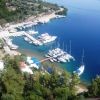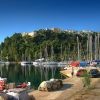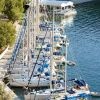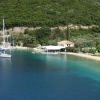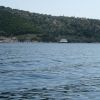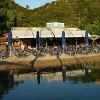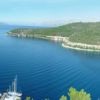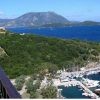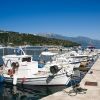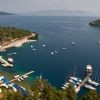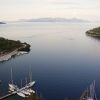SPARTOHORI (SPILIA) bay in MEGANISI ISLAND (LEFKADA) Featured
Spartohori (or Spilia) is a very beautiful bay which is very popular among boaters because it offers safe mooring places, facilities but keeps its pure authentic atmosphere. It has quays and the taverna owner will help you moor. Eating at the taverna right on the peebly beach is considered a must! The place is cool, relaxed, full of trees. The bay does not have any other shops or things to do. You may swim in the beach at the endo of the bay which is good but not one of the best in the island.....
The village of Spartohori is perched high above Spilia Bay and has a couple of minimarkets, little shops and tavernas. It can be reached by a 10 minute walk up the road or steps and offers spectacular views across the sea to the mountains of the mainland.
GENERAL INFORMATION ABOUT MEGANISI: Meganisi is a tiny island located 4 n.m. from Nidri port (see separate listing) at the eastern side of Lefkada island. In Greek Meganisi means "large island" but paradoxically it overs only 19.85 sq. km. It is presently inhabited by approximately 1500 permanent residents and has been inhabited from time immemorial. Mentioned as far back as Homer's time this island has a long history.... Visiting Meganisi is like taking a step back in time. The island is unspoilt, charming and beautiful. There are numerous bays to explore, some caves to snorkel in and villages to amble around.....The two main harbours of Vathi (see separate listing) and Spilia offer safe moorings. Each has waterside tavernas. Above these two harbours are the quaint villages of Katomeri  and Spartohori. A labyrinth of tiny lanes and alleyways form a maze of whitewashed houses and courtyards full of tin-potted plants. Picturesque churches occupy sites with the best sea views and a few tavernas offer tasty meals......Meganisi is very popular among boaters because it has marvelous beaches with calm crystal turquoise waters and the famous Papanikolis marine cave.....Nowdays residents harvest the olive trees, milk their sheep and feed their chicken. In bygone years these villages were the centres of activity. ...Everybody joined in with the olive harvest to make oil to sell and corn was grown and milled in one of the many windmills to make flou.
and Spartohori. A labyrinth of tiny lanes and alleyways form a maze of whitewashed houses and courtyards full of tin-potted plants. Picturesque churches occupy sites with the best sea views and a few tavernas offer tasty meals......Meganisi is very popular among boaters because it has marvelous beaches with calm crystal turquoise waters and the famous Papanikolis marine cave.....Nowdays residents harvest the olive trees, milk their sheep and feed their chicken. In bygone years these villages were the centres of activity. ...Everybody joined in with the olive harvest to make oil to sell and corn was grown and milled in one of the many windmills to make flou.
Photos provided by Alan Ramsay.

